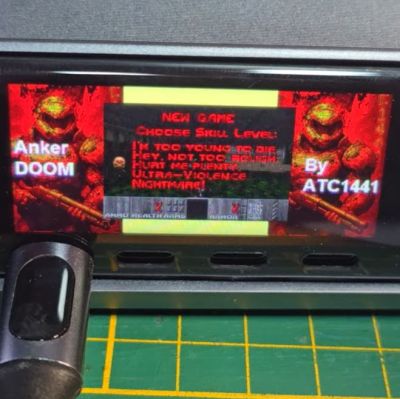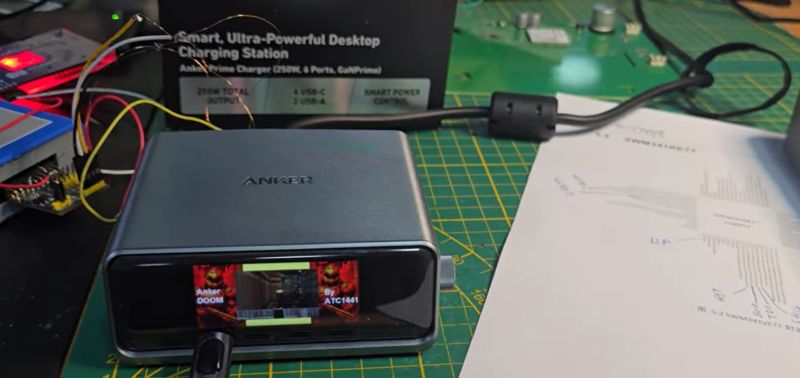At this point the question is no longer whether a new device runs DOOM, but rather how well. In the case of Anker’s Prime Charging Station it turns out that it’s actually not too terrible at controlling the game, as [Aaron Christophel] demonstrates. Unlike the similar Anker power bank product with BLE and a big display that we previously covered, this device has quite the capable hardware inside.

According to [Aaron], inside this charging station you’ll not only find an ESP32-C3 for Bluetooth Low Energy (BLE) duty, but also a 150 MHz Synwit SWM341RET7 (Chinese datasheet) ARM-based MCU along with 16 MB of external flash and 8 MB of external RAM. Both of these are directly mapped into the MCU’s memory space. The front display has a 200×480 pixel resolution.
This Synwit MCU is a bit of a curiosity, as it uses ARM China’s Star-MC1 architecture for which most of the information is in Chinese, though it’s clear that it implements the ARMv8-M profile. It can also be programmed the typical way, which is what [Aaron] did to get DOOM on it, with the clicky encoder on the side of the charging station being the sole control input.
As can be seen in the video it makes for a somewhat awkward playing experience, but far more usable than one might expect, even if running full-screen proved to be a bit too much for the hardware.
















For a charging station? I joke about the 100MB hello world these days but why does a charging station need such hardware
It’s not even that expensive for what you get and some people like to look at pretty things. Why get a Toyota when you can get a Lexus. It’s 170 dollars, the biggest competitor when you look at the specifications is the chinese brand Satechi charger which is 150 dollars. Might as well get this one. Otherwise you end up losing options, less ports etc. There are much cheaper methods to do the same thing, sure, but not as pretty. You can get a 6 port power strip and 6 cheap GaN chargers. It’s cheaper. I have no use for this, I already have the PinePower Desktop which is more than enough for me, but it’s a completely different league.
Bluetooth allows for firmware updates and monitoring if it charges properly.
I have more respect for the ones that use write once microcontrollers.
Why a power bank needs Bluetooth escapes me. If it was an open standard maybe some use, but I say no to bloated proprietary apps. Double so when riddled with ads (even for the companies own products) and ‘cutting edge’ UI, which not only will look dated soon, is usually less useful than a simple design.
Off topic, why not keep your design same? While people complain about the style of other companies changing you do nothing. Then you have a couple years where you look out of date, then your style is back in fashion and you don’t have to scramble to go back to the old style. You saved 2 design cycles and can spend the money making the App/whatever better to actually use.
Why do you have respect for products that use write once microcontrollers? The only reasons to use them are to save cost or prevent the hardware from being repurposed. Given how cheap microcontrollers with normal flash are, write once microcontrollers really aren’t that much of a saving now so if a company uses it then it is likely making compromises elsewhere too.
Write once also means the company has no option to update the product, in the case of a charging station like this it could potentially be updated to fix compatibility issues with some devices using USB PD or to implement new PD standards or add support for proprietary standards sometimes used by phone manufacturers.
Most likely for helping with power negotiation and thermal management. They supposedly scan a crap ton whilst its charging to make sure it doesn’t overheat.
Sounds like something a 20MHz AVR would be overspecified for?
I’ve been wondering recently, how much computing power is in a USB-C dock? The kind that has 1G Ethernet, HDMI 2.1, and plenty of USB 3.1. It wouldn’t surprise me if there’s something hack-able inside, begging to run DOOM.
I have been having fun with vapes I find in my yard (neighbor has teens which have pool parties and they just throw them when they are done). At first it was to harvest the bms and battery because free and some of the newer ones come with a full useable uC in there. The more features and cheaper it looks, the less secure it is. Most are specific, low run china/mordor cores that run some little sketch for the screen, LEDS, charger, toke switch, and actual vaporizing/temp. I got lucky on the last one with an actual OLED display and a little broadcomm chip to play with and did up a flappy birds kind of game with its display and a snake game demo. These are all one-shot vapes meant to be disposed of afterwards. As for the USBC dock I wish you luck! I tried with tried with an older thinkpad dock a neighbor tossed. I thought man there must be something to do with something that can control that many things and output video and audio but even with AI helping me, we kinda waved it off in the end. In my case, there was no cpu that thought it was a cpu, and though I could have spent the week cutting traces and rerouting data to make it work, I just put it in a parts box for the ports lol. I think you are right about the USBC factor though. That ups the ante a good bit and might give you a better set up to mod. From my experience it was the lack of ram and storage that scuttled quite a few attempts. Having to do a lot of legwork to figure out what works with the cpu and buss, what commands are allowed in the oems proprietary shell (always missing the one you need lol), and something that is built for that purpose is just more effort than it might be worth outside of fun stuff like doom hacking. I admit though when I open something up and I see something that looks like a uart header, I get a little rush of “hmmm what can you do?” lol.
Please share internal pictures of that vape !
Trying to get my hands on one but in germany thats not simple to get
No, all they need is a PD device to negotiate and everything else is just hanging off the pins supplied in the port. EG the USB based Ethernet port and USB hub, maybe a MST (Multi-Stream Transport, DisplayPort technology for multi-monitor).
There are a handful that have a Graphics processor inside, but those still just connect to the thunderbolt PCIe.
How soon before things like this have a known (as opposed to undisclosed) “it runs Doom from the factory” easter-egg the day the product ships?
makes me wonder if somebody wanted to do that but some sort of “no commercial distribution” clause in every Doom distribution would disallow that. kind of like how Capcom was caught stealing open source emulators in their fight sticks.
They use overpowered hardware most likely because it’s part of their standard platform they use for higher end products that need more processing power also. Saving $2 on a BOM is negligible when their time to market blows up because of messing will all different hardware configurations and vendors. All large OEMs and CMs do this.